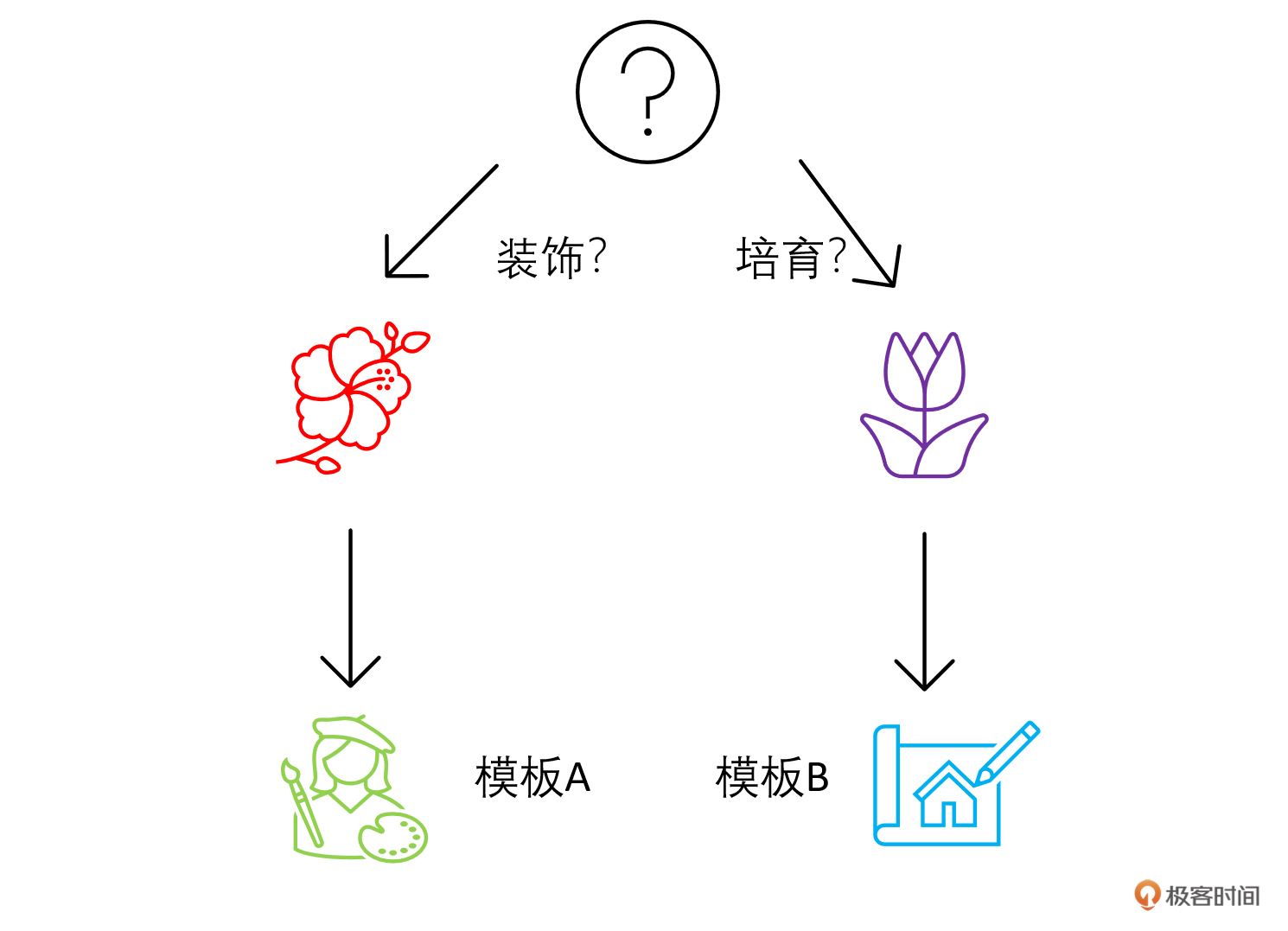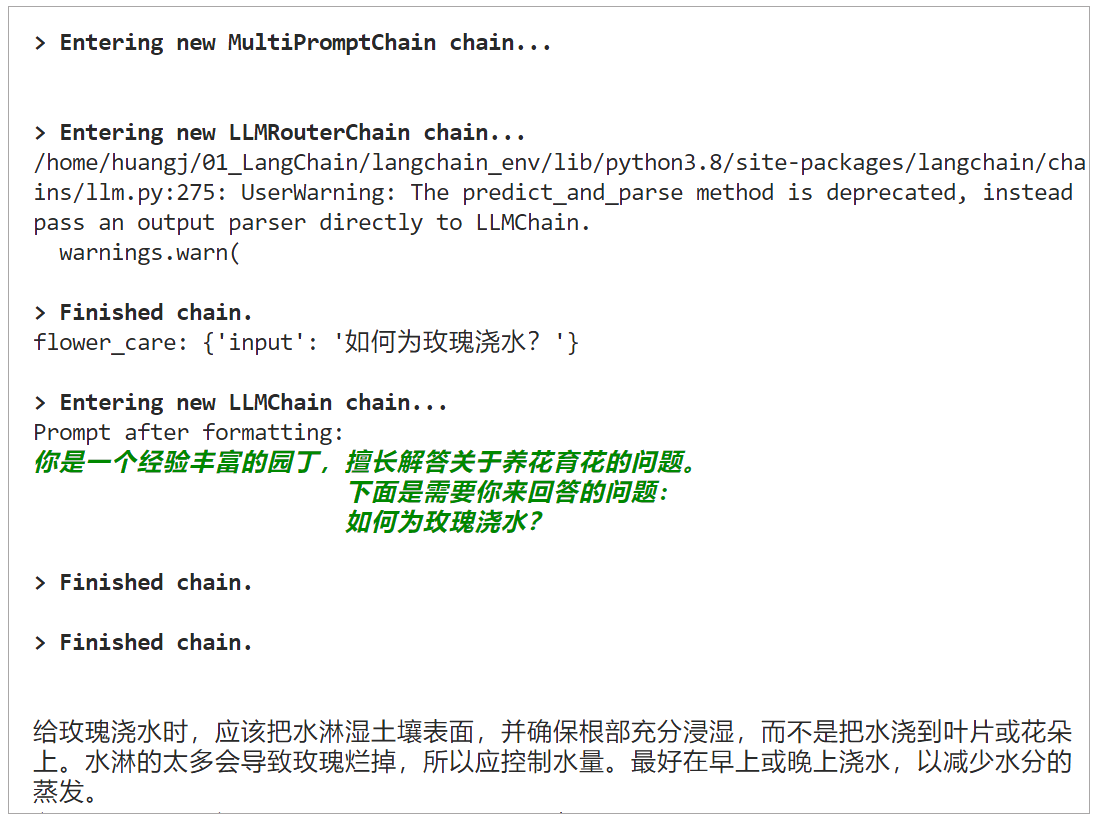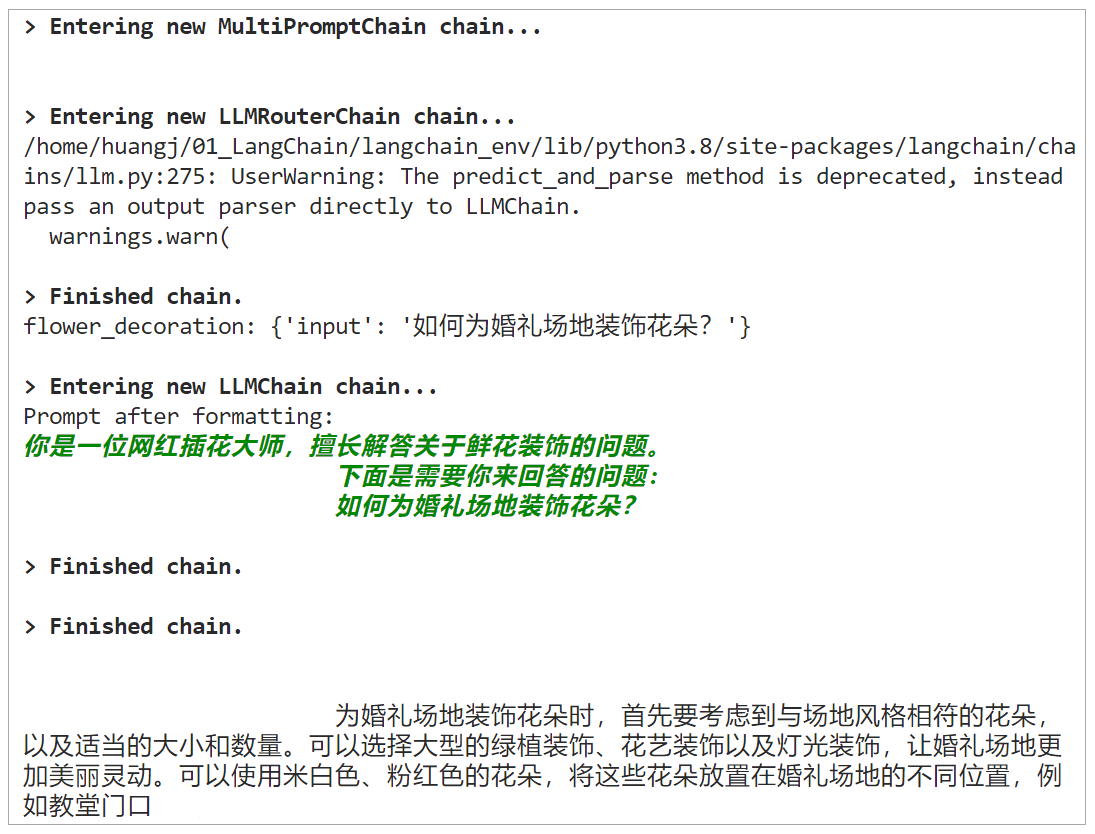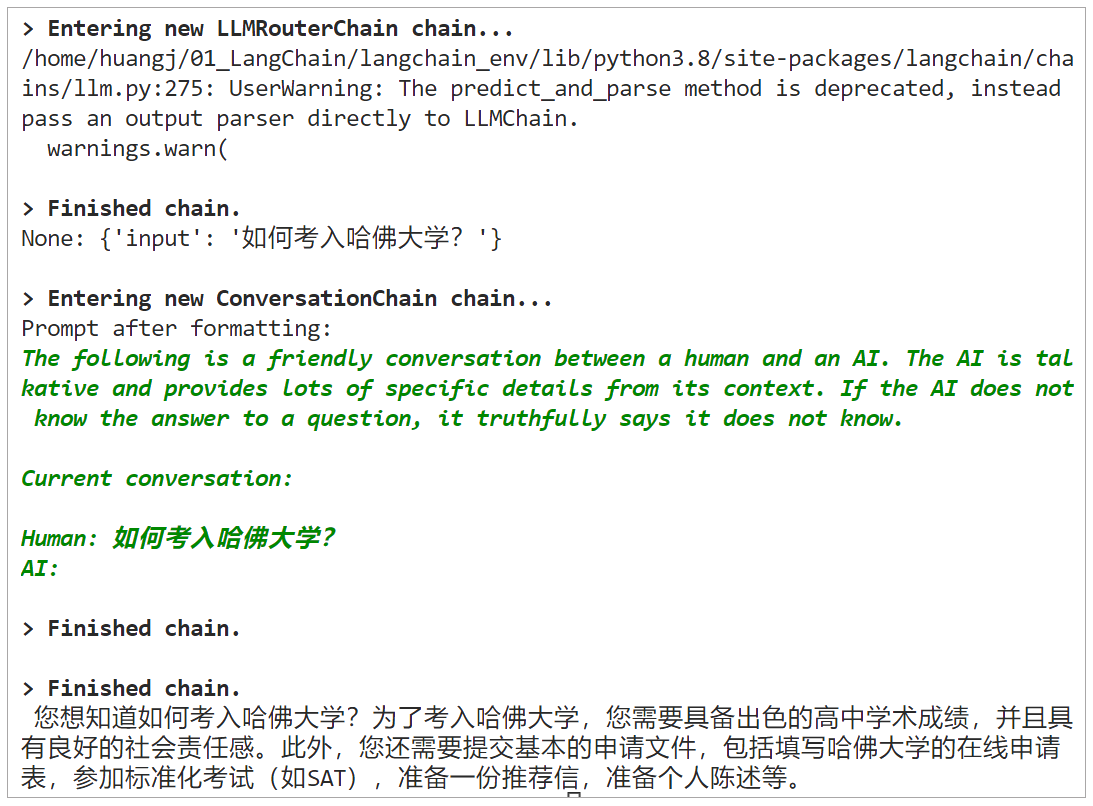09 链(下):想学“育花”还是“插花”?用RouterChain确定客户意图
你好,我是黄佳。欢迎来到LangChain实战课!
上一节课中,我带着你学习了Chain的基本概念,还使用了LLMChain和SequencialChain,这一节课,我们再来看看其他类型的一些Chain的用法。
任务设定
首先,还是先看一下今天要完成一个什么样的任务。
这里假设咱们的鲜花运营智能客服ChatBot通常会接到两大类问题。
- 鲜花养护(保持花的健康、如何浇水、施肥等)
- 鲜花装饰(如何搭配花、如何装饰场地等)
你的需求是,如果接到的是第一类问题,你要给ChatBot A指示;如果接到第二类的问题,你要给ChatBot B指示。

我们可以根据这两个场景来构建两个不同的目标链。遇到不同类型的问题,LangChain会通过RouterChain来自动引导大语言模型选择不同的模板。
当然我们的运营过程会遇到更多种类的问题,你只需要通过同样的方法扩充逻辑即可。
整体框架
RouterChain,也叫路由链,能动态选择用于给定输入的下一个链。我们会根据用户的问题内容,首先使用路由器链确定问题更适合哪个处理模板,然后将问题发送到该处理模板进行回答。如果问题不适合任何已定义的处理模板,它会被发送到默认链。
在这里,我们会用LLMRouterChain和MultiPromptChain(也是一种路由链)组合实现路由功能,该MultiPromptChain会调用LLMRouterChain选择与给定问题最相关的提示,然后使用该提示回答问题。
具体步骤如下:
- 构建处理模板:为鲜花护理和鲜花装饰分别定义两个字符串模板。
- 提示信息:使用一个列表来组织和存储这两个处理模板的关键信息,如模板的键、描述和实际内容。
- 初始化语言模型:导入并实例化语言模型。
- 构建目标链:根据提示信息中的每个模板构建了对应的LLMChain,并存储在一个字典中。
- 构建LLM路由链:这是决策的核心部分。首先,它根据提示信息构建了一个路由模板,然后使用这个模板创建了一个LLMRouterChain。
- 构建默认链:如果输入不适合任何已定义的处理模板,这个默认链会被触发。
- 构建多提示链:使用MultiPromptChain将LLM路由链、目标链和默认链组合在一起,形成一个完整的决策系统。
具体实现
下面,就是用路由链自动选择处理模板的具体代码实现。
构建提示信息的模板
首先,我们针对两种场景,构建两个提示信息的模板。
# 构建两个场景的模板
flower_care_template = """你是一个经验丰富的园丁,擅长解答关于养花育花的问题。
下面是需要你来回答的问题:
{input}"""
flower_deco_template = """你是一位网红插花大师,擅长解答关于鲜花装饰的问题。
下面是需要你来回答的问题:
{input}"""
# 构建提示信息
prompt_infos = [
{
"key": "flower_care",
"description": "适合回答关于鲜花护理的问题",
"template": flower_care_template,
},
{
"key": "flower_decoration",
"description": "适合回答关于鲜花装饰的问题",
"template": flower_deco_template,
}]
初始化语言模型
接下来,我们初始化语言模型。
# 初始化语言模型
from langchain.llms import OpenAI
import os
os.environ["OPENAI_API_KEY"] = '你的OpenAI Key'
llm = OpenAI()
构建目标链
下面,我们循环prompt_infos这个列表,构建出两个目标链,分别负责处理不同的问题。
# 构建目标链
from langchain.chains.llm import LLMChain
from langchain.prompts import PromptTemplate
chain_map = {}
for info in prompt_infos:
prompt = PromptTemplate(template=info['template'],
input_variables=["input"])
print("目标提示:\n",prompt)
chain = LLMChain(llm=llm, prompt=prompt,verbose=True)
chain_map[info["key"]] = chain
这里,目标链提示是这样的:
目标提示:
input_variables=['input']
output_parser=None partial_variables={}
template='你是一个经验丰富的园丁,擅长解答关于养花育花的问题。\n 下面是需要你来回答的问题:\n
{input}' template_format='f-string'
validate_template=True
目标提示:
input_variables=['input']
output_parser=None partial_variables={}
template='你是一位网红插花大师,擅长解答关于鲜花装饰的问题。\n 下面是需要你来回答的问题:\n
{input}' template_format='f-string'
validate_template=True
对于每个场景,我们创建一个 LLMChain(语言模型链)。每个链会根据其场景模板生成对应的提示,然后将这个提示送入语言模型获取答案。
构建路由链
下面,我们构建路由链,负责查看用户输入的问题,确定问题的类型。
# 构建路由链
from langchain.chains.router.llm_router import LLMRouterChain, RouterOutputParser
from langchain.chains.router.multi_prompt_prompt import MULTI_PROMPT_ROUTER_TEMPLATE as RounterTemplate
destinations = [f"{p['key']}: {p['description']}" for p in prompt_infos]
router_template = RounterTemplate.format(destinations="\n".join(destinations))
print("路由模板:\n",router_template)
router_prompt = PromptTemplate(
template=router_template,
input_variables=["input"],
output_parser=RouterOutputParser(),)
print("路由提示:\n",router_prompt)
router_chain = LLMRouterChain.from_llm(llm,
router_prompt,
verbose=True)
输出:
路由模板:
Given a raw text input to a language model select the model prompt best suited for the input. You will be given the names of the available prompts and a description of what the prompt is best suited for. You may also revise the original input if you think that revising it will ultimately lead to a better response from the language model.
<< FORMATTING >>
Return a markdown code snippet with a JSON object formatted to look like:
```json
{{
"destination": string \ name of the prompt to use or "DEFAULT"
"next_inputs": string \ a potentially modified version of the original input
}}
```
REMEMBER: "destination" MUST be one of the candidate prompt names specified below OR it can be "DEFAULT" if the input is not well suited for any of the candidate prompts.
REMEMBER: "next_inputs" can just be the original input if you don't think any modifications are needed.
<< CANDIDATE PROMPTS >>
flower_care: 适合回答关于鲜花护理的问题
flower_decoration: 适合回答关于鲜花装饰的问题
<< INPUT >>
{input}
<< OUTPUT >>
路由提示:
input_variables=['input'] output_parser=RouterOutputParser(default_destination='DEFAULT', next_inputs_type=<class 'str'>, next_inputs_inner_key='input')
partial_variables={}
template='Given a raw text input to a language model select the model prompt best suited for the input. You will be given the names of the available prompts and a description of what the prompt is best suited for. You may also revise the original input if you think that revising it will ultimately lead to a better response from the language model.\n\n
<< FORMATTING >>\n
Return a markdown code snippet with a JSON object formatted to look like:\n```json\n{{\n "destination": string \\ name of the prompt to use or "DEFAULT"\n "next_inputs": string \\ a potentially modified version of the original input\n}}\n```\n\n
REMEMBER: "destination" MUST be one of the candidate prompt names specified below OR it can be "DEFAULT" if the input is not well suited for any of the candidate prompts.\n
REMEMBER: "next_inputs" can just be the original input if you don\'t think any modifications are needed.\n\n<< CANDIDATE PROMPTS >>\n
flower_care: 适合回答关于鲜花护理的问题\n
flower_decoration: 适合回答关于鲜花装饰的问题\n\n
<< INPUT >>\n{input}\n\n<< OUTPUT >>\n'
template_format='f-string'
validate_template=True
这里我说一下路由器链是如何构造提示信息,来引导大模型查看用户输入的问题并确定问题的类型的。
先看路由模板部分,这段模板字符串是一个指导性的说明,目的是引导语言模型正确处理用户的输入,并将其定向到适当的模型提示。
1. 路由模板的解释
路由模板是路由功能得以实现的核心。我们来详细分解一下这个模板的每个部分。
引言
Given a raw text input to a language model select the model prompt best suited for the input.
这是一个简单的引导语句,告诉模型你将给它一个输入,它需要根据这个输入选择最适合的模型提示。
You will be given the names of the available prompts and a description of what the prompt is best suited for.
这里进一步提醒模型,它将获得各种模型提示的名称和描述。
You may also revise the original input if you think that revising it will ultimately lead to a better response from the language model.
这是一个可选的步骤,告诉模型它可以更改原始输入以获得更好的响应。
格式说明(<< FORMATTING >>)
指导模型如何格式化其输出,使其以特定的方式返回结果。
Return a markdown code snippet with a JSON object formatted to look like:
表示模型的输出应该是一个 Markdown 代码片段,其中包含一个特定格式的 JSON 对象。
下面的代码块显示了期望的 JSON 结构,其中 destination 是模型选择的提示名称(或“DEFAULT”),而 next_inputs 是可能被修订的原始输入。
额外的说明和要求
REMEMBER: “destination” MUST be one of the candidate prompt names specified below OR it can be “DEFAULT”…
这是一个重要的指导,提醒模型 “destination” 字段的值必须是下面列出的提示之一或是 “DEFAULT”。
REMEMBER: “next_inputs” can just be the original input if you don’t think any modifications are needed.
这再次强调,除非模型认为有必要,否则原始输入不需要修改。
候选提示(<< CANDIDATE PROMPTS >>)
列出了两个示例模型提示及其描述:
- “flower_care: 适合回答关于鲜花护理的问题”,适合处理与花卉护理相关的问题。
- “flower_decoration: 适合回答关于鲜花装饰的问题”,适合处理与花卉装饰相关的问题。
输入/输出部分
<< INPUT >>\n{input}\n\n<< OUTPUT >>\n:
这部分为模型提供了一个格式化的框架,其中它将接收一个名为 {input} 的输入,并在此后的部分输出结果。
总的来说,这个模板的目的是让模型知道如何处理用户的输入,并根据提供的提示列表选择一个最佳的模型提示来回应。
2. 路由提示的解释
路由提示 (router_prompt)则根据路由模板,生成了具体传递给LLM的路由提示信息。
- 其中input_variables 指定模板接收的输入变量名,这里只有
"input"。 - output_parser 是一个用于解析模型输出的对象,它有一个默认的目的地和一个指向下一输入的键。
- template 是实际的路由模板,用于给模型提供指示。这就是刚才详细解释的模板内容。
- template_format 指定模板的格式,这里是
"f-string"。 - validate_template 是一个布尔值,如果为 True,则会在使用模板前验证其有效性。
简而言之,这个构造允许你将用户的原始输入送入路由器,然后路由器会决定将该输入发送到哪个具体的模型提示,或者是否需要对输入进行修订以获得最佳的响应。
构建默认链
除了处理目标链和路由链之外,我们还需要准备一个默认链。如果路由链没有找到适合的链,那么,就以默认链进行处理。
# 构建默认链
from langchain.chains import ConversationChain
default_chain = ConversationChain(llm=llm,
output_key="text",
verbose=True)
构建多提示链
最后,我们使用MultiPromptChain类把前几个链整合在一起,实现路由功能。这个MultiPromptChain类是一个多路选择链,它使用一个LLM路由器链在多个提示之间进行选择。
MultiPromptChain中有三个关键元素。
- router_chain(类型RouterChain):这是用于决定目标链和其输入的链。当给定某个输入时,这个router_chain决定哪一个destination_chain应该被选中,以及传给它的具体输入是什么。
- destination_chains(类型Mapping[str, LLMChain]):这是一个映射,将名称映射到可以将输入路由到的候选链。例如,你可能有多种处理文本输入的方法(或“链”),每种方法针对特定类型的问题。destination_chains可以是这样一个字典:
{'weather': weather_chain, 'news': news_chain}。在这里,weather_chain可能专门处理与天气相关的问题,而news_chain处理与新闻相关的问题。 - default_chain(类型LLMChain):当 router_chain 无法将输入映射到destination_chains中的任何一个链时,LLMChain 将使用此默认链。这是一个备选方案,确保即使路由器不能决定正确的链,也总有一个链可以处理输入。
它的工作流程如下:
- 输入首先传递给router_chain。
- router_chain根据某些标准或逻辑决定应该使用哪一个destination_chain。
- 输入随后被路由到选定的destination_chain,该链进行处理并返回结果。
- 如果router_chain不能决定正确的destination_chain,则输入会被传递给default_chain。
这样,MultiPromptChain就为我们提供了一个在多个处理链之间动态路由输入的机制,以得到最相关或最优的输出。
实现代码如下:
# 构建多提示链
from langchain.chains.router import MultiPromptChain
chain = MultiPromptChain(
router_chain=router_chain,
destination_chains=chain_map,
default_chain=default_chain,
verbose=True)
运行路由链
好了,至此我们的链路已经准备好了。现在开始提出各种问题,测试一下我们的链。
测试A:
print(chain.run(“如何为玫瑰浇水?”))
输出:

测试B:
print(chain.run(“如何为婚礼场地装饰花朵?”))
输出:

测试C:
print(chain.run(“如何考入哈佛大学?”))
输出:

这三个测试,分别被路由到了三个不同的目标链,其中两个是我们预设的“专家类型”目标链,而第三个问题:如何考入哈佛大学?被模型一眼看穿,并不属于任何鲜花运营业务场景,路由链把它抛入了一个 “default chain” —— ConversationChain 去解决。
总结时刻
在这个示例中,我们看到了LLMRouterChain以及MultiPromptChain。其中,LLMRouterChain继承自RouterChain;而MultiPromptChain则继承自MultiRouteChain。
整体上,我们通过MultiPromptChain把其他链组织起来,完成了路由功能。
chain = MultiPromptChain(
router_chain=router_chain,
destination_chains=chain_map,
default_chain=default_chain,
verbose=True)
在LangChain的 chains -> router -> base.py 文件中,可以看到RouterChain和MultiRouteChain的代码实现。
思考题
- 通过verbose=True这个选项的设定,在输出时显示了链的开始和结束日志,从而得到其相互调用流程。请你尝试把该选项设置为False,看一看输出结果有何不同。
- 在这个例子中,我们使用了ConversationChain作为default_chain,这个Chain是LLMChain的子类,你能否把这个Chain替换为LLMChain?
期待在留言区看到你的分享。如果你觉得内容对你有帮助,也欢迎分享给有需要的朋友!最后如果你学有余力,可以进一步学习下面的延伸阅读。
延伸阅读
- 在路上 👍(19) 💬(1)
ConversationChain和LLMChain的区别在于,ConversationChain有memory成员变量,能保留对话上下文,而LLMChain不行。在源码上,跟踪ConversationBufferMemory.load_memory_variables()可知,对话上下文会作为inputs的一部分传入PromptTemplate,成为llm的提示词。
2023-09-22 - 阶前梧叶 👍(5) 💬(1)
在这种路由链中,返回的数据也想做结构化json解析,那最终llm返回的结果,如何去确定是哪个chain返回的?继而选择对应的parser处理
2023-09-25 - 鲸鱼 👍(4) 💬(1)
我发现使用MultiPromptChain.from_prompts方法会更简洁,其内部实现就是老师上面列出的内容类似 flower_care_template = """ 你是一个经验丰富的园丁,擅长解答关于养花育花的问题。 下面是需要你来回答的问题: {input}""" flower_deco_template = """ 你是一位网红插花大师,擅长解答关于鲜花装饰的问题。 下面是需要你来回答的问题: {input}""" prompt_infos = [ { 'name': 'flower_care', 'description': '适合回答关于鲜花护理的问题', 'prompt_template': flower_care_template, }, { 'name': 'flower_decoration', 'description': '适合回答关于鲜花装饰的问题', 'prompt_template': flower_care_template, }, ] llm = OpenAI() chain = MultiPromptChain.from_prompts(llm=llm, prompt_infos=prompt_infos, verbose=True) print(chain.run("如何为玫瑰浇水?"))
2023-10-27 - 黄振宇 👍(3) 💬(1)
感觉router_chain是一个agent了,只不过agent调用的是不同的tool,router_chain调用的是其他的大模型LLM
2023-09-21 - 阿斯蒂芬 👍(2) 💬(1)
打卡 mark!课跟上了,代码还没跟上。chains 的理念算不算就是利用LLM来驱动LLM?
2023-09-22 - dydcm 👍(0) 💬(1)
老师您好,我跑样例的时候一直报一个错,能麻烦帮忙看下原因吗?报错如下: The above exception was the direct cause of the following exception: 。。。 File "/Library/Frameworks/Python.framework/Versions/3.12/lib/python3.12/site-packages/langchain/utils/__init__.py", line 15, in <module> from langchain.utils.math import cosine_similarity, cosine_similarity_top_k File "/Library/Frameworks/Python.framework/Versions/3.12/lib/python3.12/site-packages/langchain/utils/math.py", line 5, in <module> import numpy as np File "/Library/Frameworks/Python.framework/Versions/3.12/lib/python3.12/site-packages/numpy/__init__.py", line 135, in <module> raise ImportError(msg) from e ImportError: Error importing numpy: you should not try to import numpy from its source directory; please exit the numpy source tree, and relaunch your python interpreter from there.
2023-12-05 - SH 👍(0) 💬(1)
这节里面的问题,如果使用 当前的 ChatGPT 我们如果直接向他提问的时候,他的内部是否已经帮助我调整好了相关的提示模版,通过相关的链 来回答相关的问题呢? 实际测试了一下,没有提示模板问,与加了提示模板(告诉他是个专门),两种方式输出的确会有些差异;
2023-11-05 - sunny 👍(0) 💬(4)
文章中的这一段话: (RouterChain,也叫路由链,能动态选择用于给定输入的下一个链。我们会根据用户的问题内容,首先使用路由器链确定问题更适合哪个处理模板,然后将问题发送到该处理模板进行回答。如果问题不适合任何已定义的处理模板,它会被发送到默认链。) 我的疑问是:这里指路由链是能自动推理出用户意图,进而选择对应意图所要走的任务处理目标链吗;不需要通过写prompt+用户输入送入到大模型让大模型进行自动推理做选择题输出意图吗? (比如写个prompt: 请理解这一段话{变量=用户输入},判断这段话是想进行[鲜花养护]还是[鲜花培育]; ##若是鲜花养护请输出"A",若是鲜花培育输出”B“) 这样得到到了A或B判断出了用户意图走哪个目标链
2023-10-16 - Geek_19a2eb 👍(0) 💬(2)
就是当输入的内容匹配不上其他的链的时候到默认路由这报错 其他的链都是正常的 报错信息如下,麻烦老师帮忙看下 刚入门的小白,多多理解:OutputParserException: Parsing text ```json { "destination": "DEFAULT", "next_inputs": "如何考入哈佛大学?" } raised following error: Got invalid JSON object. Error: Expecting value: line 1 column 1 (char 0)
2023-10-16 - Geek_19a2eb 👍(0) 💬(1)
老师您好 我运行到print(chain.run(“如何考入哈佛大学?”))的时候报错 能给看下是啥原因吗 报错如下: OutputParserException: Parsing text ```json { "destination": "DEFAULT", "next_inputs": "如何考入哈佛大学?" } raised following error: Got invalid JSON object. Error: Expecting value: line 1 column 1 (char 0)
2023-10-16 - 漏网之渔 👍(0) 💬(1)
RouterChain中每个分支chain的输入参数要求是相同的么,可以使用不同数量的参数么
2023-10-10 - 夏落de烦恼 👍(0) 💬(1)
langchain有集成文心一言么?这个案例能用在文心一言上么?
2023-10-07 - zhouqin 👍(0) 💬(1)
建议有开发经验的同学,先通过gpt把作者文章核心点精炼出来。然后用作者通过LangChain模板跑出的提示词,通过gpt或者claude做验证。多跑几遍就能感觉到大模型的思维方式。最后再去看代码。事半功倍、、:》
2023-10-05 - Geek_7ca963 👍(0) 💬(1)
老师,Agent 和 Chain 到底有啥区别 ? chain 似乎也可以做 act,甚至判断用途
2023-09-30 - Webber 👍(0) 💬(2)
老师啥时候更新agent的内容啊,我在用langchain做一个agent。遇到一个问题,就是在最开始输入的是一个query,比如:帮我从上海中心大厦导航到上海虹桥火车站,agent此时决定去调用高德导航这个tool,高德导航tool接收的输入是出发地和目的地,那么这个出发地和目的地是怎么解析出来传给高德导航tool的呢,是在自定义tool的description中写prompt让模型提取出发地和目的地两个实体吗,不懂怎么才能给想要调用的tool传递tool需要的参数。如果有10个tool,每个tool接收的输入参数都不一样,不知道怎么才能实现给指定tool传递特定参数的目标。
2023-09-22